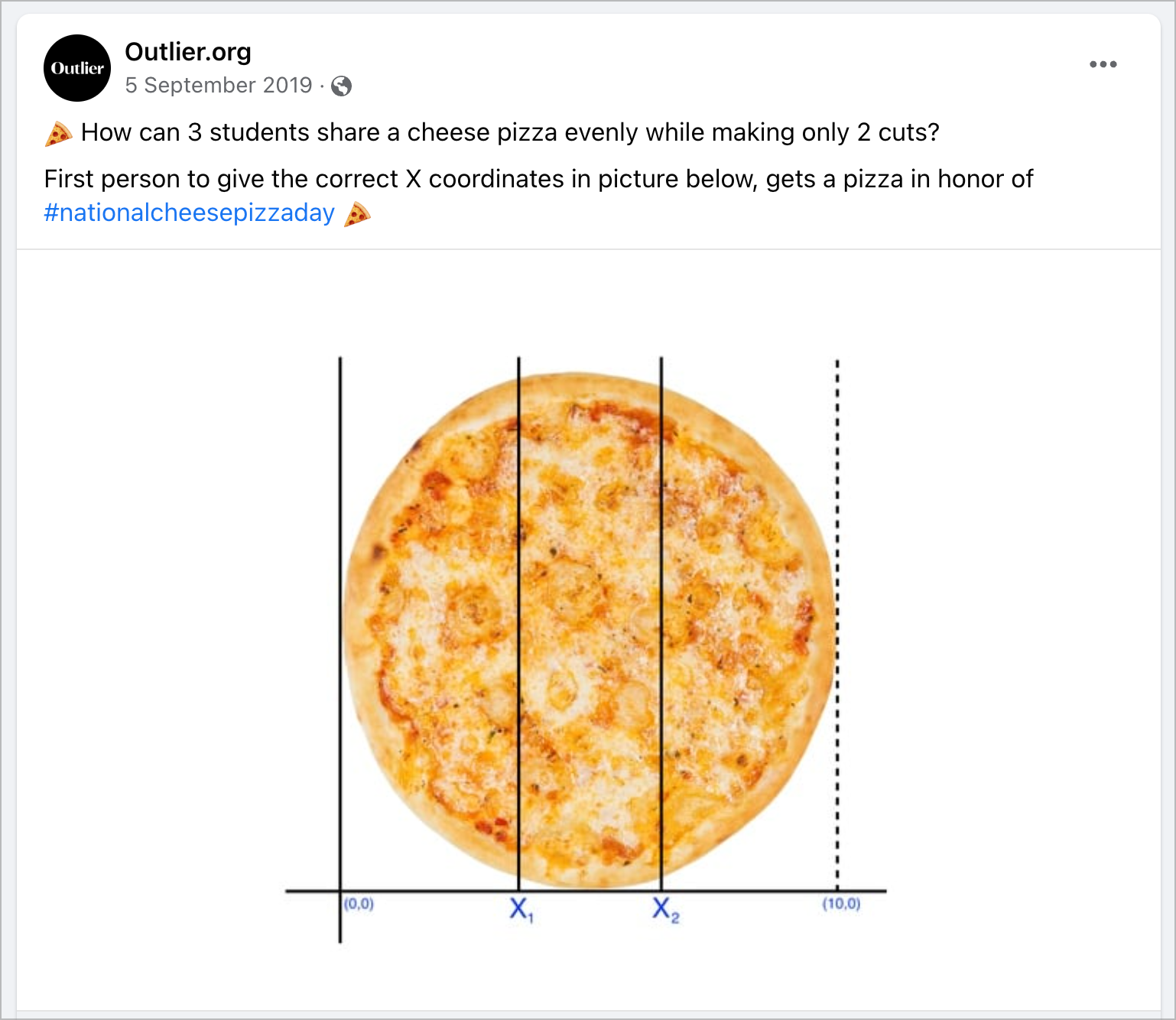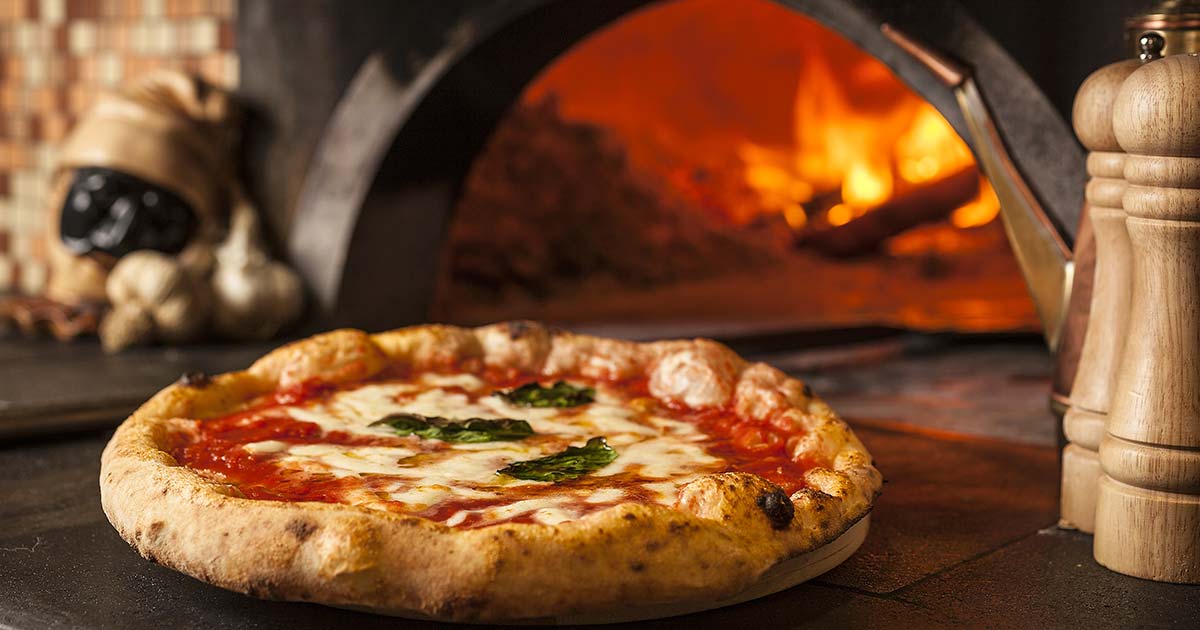There’s no limit to creativity. Maybe time, but it still tends to infinite. Therefore it has no limit either.
What about pizzas? Well, pizzas can have a limit. You slice it traditionally in \(S = 1, 2, 4, 8, 16, …, n \) slices or as an alternative, cut it on segments. It’s not very common to encounter a pizza slice in segments outside Latin America. However, yesterday, one tweet brought it to my attention to one of these online challenges requiring the follower to slice a pizza into three equal parts, defining only two segments.

The way the graphic indicates induces the assumption that answers should be towards creating segments with the proposed \(x_1\) and \(x_2\) cuts and if you want to work this problem out, you’ll probably reach the proposed solution. Not without scratch your head recalling your geometry and trigonometry knowledge. The solution is \(x_1 = 3.675\) and \(x2 = 6.325\).
That is a solution, for sure. However, imagine using the same approach if you continue and slice the pizza in even more parts. You’re probably wondering how can we deal with the even more complicated arc calculations that are necessary to define the cuts proportionally.
So, what is the alternate way, then?
During my high school years, I’ve stumbled across a slightly peculiar mathematics book. It was written in Spanish, smelly, and filled up with fading pencil page notes. I’ve tried to remember the book name for years, but nowadays I’m sure that it was a translation for Kiselev’s geometry book1. Prof. Alexander Givental2 adapted the Russian original text into two volumes: Kiselev’s Geometry Book I. Planimetry3 and Book II. Stereometry4. The Spanish version I had access to, was probably a donation from some engineer who worked at the Itaipu Dam in my home city.
However, until that point in my life, my relation to mathematics leaned towards fiddling with equations until I stumbled in the right answer, which matched the answers sheet. I had no idea what a mathematical proof or anything in the regular undergrad toolbox was. So I approached the problems, always repeating the same pattern. Trying out the exercises in this book was the recipe to hit several frustrating roadblocks as it contained a series of increased complexity exercises. There’s a point beyond a certain complexity level the math I knew wasn’t enough to find an answer.
One exercise in this book was presented similarly as the initial question above, and whenever I see some disk this pops back on my mind.
- Construct a disk equivalent to a given ring (i.e., the figure bounded by two concentric circles)
- Divide a disk into $2,3 … n $ equivalent parts by concentric circles.
The first part was quite easy to solve. Following the descriptive geometry approach which the book suggests, you draw two concentric circles and shade the area between then. I used to hate this, but nowadays I see it correlates a lot with programming.
8 rings: with proportional radii
Now with the second part, and as you may have guessed at this point, it can be used to solve the proposed question above. There’s one catch, as when it says equivalent parts, it’s talking about the area as the follow-up exercises require this assumption.
Now we should solve the problem out to find the proportionality between the radii and the number of partitions. The naively wrong approach would assume we can divide the radius into $n$ parts as the picture above, and the problem would be solved. Unfortunately, that’s not that straightforward as the areas would be different.
Prof. Carlos, was not my actual teacher but enjoyed a good conversation and a challenge. He was mentoring me out of my mathematical misery. He gave me books, problems, and steered me in the right direction. Not always, as he also gave me misdirected hints to see if I was not distracted from the problem. I still remember the day we solved this puzzle. He introduced me to several concepts I’d only fully understand later in my studies as induction, series, limits, and integration.
However, back to the problem, that this is going to get interesting. Let’s outline our facts about it.
Given the radius of the outer circle as $R$ or $r_n$
Given the area of a circle is $A=\pi R^2$
Let the radius of the inner concentric circles (including the central point) be $(r_0, r_1, \ldots, r_{n-1})$
Therefore $r_{n} = \sum_{i = 0}^{n-1} (r_i)$ or the outer radius is the sum of all inner radius
The above statements define our problem and set some relationships between the concentric circles, but what we want is to express the area proportional across all rings as $A_n = \frac{\pi R^2}{n}$ and find the relationship between the radius that satisfies this statement.
It’s probably not a surprise to you that the ring-shaped object is the region bounded by two concentric circles has a name, and it’s called Annulus5. Furthermore, the area of an annulus is the difference in the areas of the larger circle of radius $R$ and the smaller one of radius $r$. I won’t enter the realm of calculus at this moment, but this can be archived using Polar integration6, and that would blow up my initial argument that the first solution was verbose.
Given $A_{anulus} = \pi\left(R^2 - r^2\right)$
$A_0 = \pi*0$
$A_1 = \pi(r_1^2-r_{0}^2) = \pi r_1^2$
The area of a ring as the difference between itself and it’s inner concentric circle as $A_i = \pi(r_i^2-r_{i-1}^2)$
We want to make $A = \pi(r_i^2-r_{i-1}^2) + \pi(r_{i-1}^2-r_{i-2}^2) + \ldots + A_0$
Arranging this equality in a series form, $\pi R^2 = \pi [ (r_i^2-r_{i-1}^2) + (r_{i-1}^2-r_{i-2}^2) + \ldots + A_0 ]$ it can be rewritten as $r_i=R\sqrt {\frac {i}{n}}$ where $n$ is the number of rings.
Presto! We found a way to express the radius as it shrinks toward the inner circle. Therefore, you can easily slice a pizza with radius R by n persons slicing it in the function of this.
So now you’re thinking this solution is pretty neat, and we that should write some code to split the pizza between our peers fairly.
import math
def sliceArea(disk_radius, rings):
return (math.pi * math.pow(disk_radius * math.sqrt(1/rings), 2))
def diskInnerRadius(disk_radius, rings, ring):
return disk_radius * math.sqrt(ring/rings)
def diskInnerRadii(disk_radius, rings):
solution = []
for i in range(1,rings + 1):
solution.append(diskInnerRadius(disk_radius, rings, i))
return solutionnote that we should consider rings as integers and areas as float.
But, wait a minute. Can you slice a pizza this way?
Although this method seems mathematically fair, I had intentionally left the final result of the disk partitioning until now to avoid spoiling out the surprise. Take a look as the outer ring thickness seems to shrink as the radius increases. Odd but correct.
8 rings: The 'fair' or maybe not
We already wrote a simple proof above that shows all the rings have the same area, which means the same amount the pizza. However, as we increase the division, the outer rings become thinner, leaving you with a tiny edge slice compared to the center. Good luck trying to handle the outer ring.
Using the code we wrote, we can check that indeed, all the areas have the same size in a radius 10 disk with 8 rings.
rings area: [39.26990817 39.26990817 39.26990817 ... ]50 rings: Way impractical, but a nice pattern is forming
Can we use this to something else?
Well, the first thing that comes to my mind is to fix weather and blast radius representations. I’ve seen countless times reporters to comment out the area of some natural damage is twice as previously estimated because it was within a radius X and now we’re at radius 2X. Now you know that’s not true.
Since this post is already a bit extense, I’ll keep the further developments to a follow-up. However, in a sneak peek - it has something to do with music, bombs and self-driving cars.
Appendix: what’s the fanciest way to slice a pizza?
It starts with the broad question, can we cut a flat disk into equal-equal sized pieces with some not touching the center?
The researchers demonstrated that it is possible to cut a flat disc into scythe-shaped, curved slices with any odd-number of sides – known as 5-gons, 7-gons, 9-gons. The paper describing the solution is named Infinite families of monohedral disk tilings7
A nice youtube video can help us visualize the solution better.
A. P., Kiselev, Elementary geometry. For secondary schools. With the application of a large number of exercises and articles ↩︎
A. P. Kiselev, Alexander Givental, Kiselev’s Geometry, Book I. Planimetry 2006 ↩︎
A. P. Kiselev, Alexander Givental, Kiselev’s Geometry, Book II. Stereometry, 2008 ↩︎
Infinite families of monohedral disk tilings - https://arxiv.org/abs/1512.03794 ↩︎
